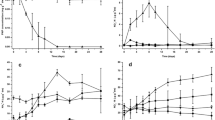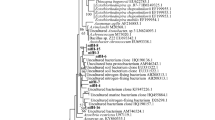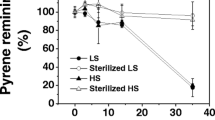Abstract
Assessing in situ microbial abilities of soils to degrade pesticides is of great interest giving insight in soil filtering capability, which is a key ecosystem function limiting pollution of groundwater. Quantification of pesticide-degrading gene expression by reverse transcription quantitative PCR (RT-qPCR) was tested as a suitable indicator to monitor pesticide biodegradation performances in soil. RNA extraction protocol was optimized to enhance the yield and quality of RNA recovered from soil samples to perform RT-qPCR assays. As a model, the activity of atrazine-degrading communities was monitored using RT-qPCRs to estimate the level of expression of atzD in five agricultural soils showing different atrazine mineralization abilities. Interestingly, the relative abundance of atzD mRNA copy numbers was positively correlated to the maximum rate and to the maximal amount of atrazine mineralized. Our findings indicate that the quantification of pesticide-degrading gene expression may be suitable to assess biodegradation performance in soil and monitor natural attenuation of pesticide.




Similar content being viewed by others
References
Ameziane N, Bogard M, Lamoril J (2006) Principes de biologie moléculaire en biologie clinique, Elsevier, Paris
Arbeli Z, Fuentes C (2010) Prevalence of the gene trzN and biogeographic patterns among atrazine-degrading bacteria isolated from 13 Colombian agricultural soils. FEMS Microbiol Ecol 73:611–623
Baelum J, Henriksen T, Hansen HCB, Jacobsen CS (2006) Degradation of 4-chloro-2-methylphenoxyacetic acid in top- and subsoil is quantitatively linked to the class III tfdA gene. Appl Environ Microbiol 72:1476–1486
Baelum J, Nicolaisen MH, Holben WE, Strobel BW, Sorensen J, Jacobsen CS (2008) Direct analysis of tfdA gene expression by indigenous bacteria in phenoxy acid amended agricultural soil. ISME J 2:677–687
Bending GD, Lincoln SD, Edmondson RN (2006) Spatial variation in the degradation rate of the pesticides isoproturon, azoxystrobin and diflufenican in soil and its relationship with chemical and microbial properties. Environ Pollut 139:279–287
Bers K, Sniegowski K, De Mot R, Springael D (2012) Dynamics of the linuron hydrolase libA gene pool size in response to linuron application and environmental perturbations in agricultural soil and on-farm biopurification systems. Appl Environ Microb 78:2783–2789
Bouskill NJ, Barnhart EP, Galloway TS, Handy RD, Ford TE (2007) Quantification of changing Pseudomonas aeruginosa sodA, htpX and mt gene abundance in response to trace metal toxicity: a potential in situ biomarker of environmental health. FEMS Microbiol Ecol 60:276–286
Calvet R, Barriuso E, Bedos C, Benoit P, Charnay M-P, Coquet Y (2005) Les pesticides dans le sol, conséquences agronomiques et environnementales, Paris
Cheyns K, Martin-Laurent F, Bru D, Aamand J, Vanhaecke L, Diels J, Merckx R, Smolders E, Springael D (2012) Long-term dynamics of the atrazine mineralization potential in surface and subsurface soil in an agricultural field as a response to atrazine applications. Chemosphere 86:1028–1034
Chomczynski P (1993) A reagent for the single-step simultaneous isolation of RNA, DNA and proteins from cell and tissue samples. Biotechniques 15:532–534
Chomczynski P, Sacchi N (1987) Single-step method of RNA isolation by acid guanidium thiocyanate-phenol-chloroform extraction. Anal Biochem 162:156–159
Commissariat Général au Développement (2011) Bilan de présence des micropolluants dans les millieux aquatiques continentaux
Courty PE, Poletto M, Duchaussoy F, Buée M, Garbaye J, Martin F (2008) Gene transcription of Lactarius quietus: Quercus petraea ectomycorrhizas from a forest soil. Appl Environ Microb 74:6598–6605
Da Silva MLB, Alvarez PJJ (2007) Assessment of anaerobic benzene degradation potential using 16S rRNA gene-targeted real-time PCR. Environ Microbiol 9:72–80
de Souza ML, Sadowsky MJ, Wackett LP (1996) Atrazine chlorohydrolase from Pseudomonas sp. strain ADP: gene sequence, enzyme purification, and protein characterization. J Bacteriol 178:4894–4900
de Souza ML, Seffernick J, Martinez B, Sadowsky MJ, Wackett LP (1998a) The atrazine catabolism genes atzABC are widespread and highly conserved. J Bacteriol 180:1951–1954
de Souza ML, Wackett LP, Sadowsky MJ (1998b) The atzABC genes encoding atrazine catabolism are located on a self-transmissible plasmid in Pseudomonas sp. strain ADP. Appl Environ Microbiol 64:2323–2326
DeBruyn JM, Chewning CS, Sayler GS (2007) Comparative quantitative prevalence of Mycobacteria and functionally abundant nidA, nahAc, and nagAc dioxygenase genes in coal tar contaminated sediments. Environ Sci Technol 41:5426–5432
Devers M, Soulas G, Martin-Laurent F (2004) Real-time reverse transcription PCR analysis of expression of atrazine catabolism genes in two bacterial strains isolated from soil. J Microbiol Meth 56:3–15
Devers M, Azhari NE, Kolic N-U, Martin-Laurent F (2007) Detection and organization of atrazine-degrading genetic potential of seventeen bacterial isolates belonging to divergent taxa indicate a recent common origin of their catabolic functions. FEMS Microbiol Lett 273:78–86
Dominguez R, da Silva M, McGuire T, Adamson D, Newell C, Alvarez P (2008) Aerobic bioremediation of chlorobenzene source-zone soil in flow-through columns: performance assessment using quantitative PCR. Biodegradation 19:545–553
Dong D, Yan A, Liu H, Zhang X, Xu Y (2006) Removal of humic substances from soil DNA using aluminium sulfate. J Microbiol Meth 66:217–222
El Sebaï T, Devers-Lamrani M, Changey F, Rouard N, Martin-Laurent F (2011) Evidence of atrazine mineralization in a soil from the Nile Delta: isolation of Arthrobacter sp. TES6, an atrazine-degrading strain. Int Biodeterior Biodegrad 65:1249–1255
Fukumori F, Hausinger RP (1993) Purification and characterization of 2,4-dichlorophenoxyacetate/alpha-ketoglutarate dioxygenase. J Biol Chem 268:24311–24317
Garcia-Gonzalez V, Govantes F, Porrua O, Santero E (2005) Regulation of the Pseudomonas sp. strain ADP cyanuric acid degradation operon. J Bacteriol 187:155–167
Gonod LV, Martin-Laurent F, Chenu C (2006) 2,4-D impact on bacterial communities, and the activity and genetic potential of 2,4-D degrading communities in soil. FEMS Microbiol Ecol 58:529–537
He ZL, Gentry TJ, Schadt CW, Wu LY, Liebich J, Chong SC, Huang ZJ, Wu WM, Gu BH, Jardine P, Criddle C, Zhou J (2007) GeoChip: a comprehensive microarray for investigating biogeochemical, ecological and environmental processes. ISME J 1:67–77
Helbling DE, Ackermann M, Fenner K, Kohler H-PE, Johnson DR (2011) The activity level of a microbial community function can be predicted from its metatranscriptome. ISME J 6:902–904
Houot S, Topp E, Yassir A, Soulas G (2000) Dependence of accelerated degradation of atrazine on soil pH in French and Canadian soils. Soil Biol Biochem 32:615–625
Hurt RA, Qiu X, Wu L, Roh Y, Palumbo AV, Tiedje JM, Zhou J (2001) Simultaneous recovery of RNA and DNA from soils and sediments. Appl Environ Microb 67:4495–4503
Kazy SK, Monier AL, Alvarez PJJ (2010) Assessing the correlation between anaerobic toluene degradation activity and bssA concentrations in hydrocarbon-contaminated aquifer material. Biodegradation 21:793–800
Kong WD, Nakatsu CH (2010) Optimization of RNA extraction for PCR quantification of aromatic compound degradation genes. Appl Environ Microb 76:1282–1284
Liebich J, Wachtmeister T, Zhou J, Burauel P (2009) Degradation of diffuse pesticide contaminants: screening for microbial potential using a functional gene microarray. Vadose Zone J 8:703–710
Mandelbaum RT, Allan DL, Wackett LP (1995) Isolation and characterization of a Pseudomonas sp. that mineralizes the s-triazine herbicide atrazine. Appl Environ Microbiol 61:1451–1457
Martinez B, Tomkins J, Wackett LP, Wing R, Sadowsky MJ (2001) Complete nucleotide sequence and organization of the atrazine catabolic plasmid pADP-1 from Pseudomonas sp. strain ADP. J Bacteriol 183:5684–5697
Martin-Laurent F, Cornet L, Ranjard L, Lopez-Gutierrez J-C, Philippot L, Schwartz C, Chaussod R, Catroux G, Soulas G (2004) Estimation of atrazine-degrading genetic potential and activity in three French agricultural soils. FEMS Microbiol Ecol 48:425–435
McDaniel CS, Harper LL, Wild JR (1988) Cloning and sequencing of a plasmid-borne gene (opd) encoding a phosphotriesterase. J Bacteriol 170:2306–2311
Millenium Ecosystem Assessment (2005) Ecosystems and human well-being: synthesis. Island Press, Washington
Monard C, Martin-Laurent F, Vecchiato C, Francez A-J, Vandenkoornhuyse P, Binet F (2008) Combined effect of bioaugmentation and bioturbation on atrazine degradation in soil. Soil Biol Biochem 40:2253–2259
Monard C, Martin-Laurent F, Devers-Lamrani M, Lima O, Vandenkoornhuyse P, Binet F (2010) atz gene expressions during atrazine degradation in the soil drilosphere. Mol Ecol 19:749–759
Monard C, Vandenkoornhuyse P, Le Bot B, Binet F (2011) Relationship between bacterial diversity and function under biotic control: the soil pesticide degraders as a case study. ISME J 5:1048–1056
Muyzer G, de Waal EC, Uitterlinden AG (1993) Profiling of complex microbial populations by denaturing gradient gel electrophoresis analysis of polymerase chain reaction-amplified genes coding for 16S rRNA. Appl Environ Microbiol 59:695–700
Ogunseitan OA, Yang S, Ericson J (2000) Microbial delta-aminolevulinate dehydratase as a biosensor of lead bioavailability in contaminated environments. Soil Biol Biochem 32:1899–1906
Parekh NR, Hartmann A, Charnay M-P, Fournier J-C (1995) Diversity of carbofuran-degrading soil bacteria and detection of plasmid-encoded sequences homologous to the mcd gene. FEMS Microbiol Ecol 17:149–160
Park JW, Crowley DE (2006) Dynamic changes in nahAc gene copy numbers during degradation of naphthalene in PAH-contaminated soils. Appl Microbiol Biot 72:1322–1329
Peng JJ, Cai C, Qiao M, Li H, Zhu YG (2010) Dynamic changes in functional gene copy numbers and microbial communities during degradation of pyrene in soils. Environ Pollut 158:2872–2879
Pietramellara G, Ascher J, Borgogni F, Ceccherini M, Guerri G, Nannipieri P (2009) Extracellular DNA in soil and sediment: fate and ecological relevance. Biol Fertil Soils 45:219–235
Prosser JI (2002) Molecular and functional diversity in soil micro-organisms. Plant Soil 244:9–17
Purdy KJ, Jared RL (2005) Nucleic acid recovery from complex environmental samples. In: Methods in enzymology, Academic Press, Burlington, pp 271–292
Radosevich M, Traina SJ, Hao YL, Tuovinen OH (1995) Degradation and mineralization of atrazine by a soil bacterial isolate. Appl Environ Microb 61:297–302
Sambrook J, Russell DW (2001) Molecular cloning. Cold Spring Harbor Laboratory Press, New York
Sherchan SP, Bachoon DS (2011) The presence of atrazine and atrazine-degrading bacteria in the residential, cattle farming, forested and golf course regions of Lake Oconee. J Appl Microbiol 111:293–299
Soulas G (1993) Evidence for the existence of different physiological groups in the microbial community responsible for 2,4-D mineralization in soil. Soil Biol Biochem 25:443–449
Spain JC, Pritchard PH, Bourquin AW (1980) Effects of adaptation on biodegradation rates in sediment/water cores from estuarine and freshwater environments. Appl Environ Microb 40:726–734
Thompson BM, Lin CH, Hsieh HY, Kremer RJ, Lerch RN, Garrett HE (2010) Evaluation of PCR-based quantification techniques to estimate the abundance of atrazine chlorohydrolase gene atzA in rhizosphere soils. J Environ Qual 39:1999–2005
Top EM, Springael D (2003) The role of mobile genetic elements in bacterial adaptation to xenobiotic organic compounds. Curr Opin Biotech 14:262–269
Topp E (2003) Bacteria in agricultural soils: diversity, role and future perspectives. Can J Soil Sci 83:303–309
Turnbull GA, Ousley M, Walker A, Shaw E, Morgan JAW (2001) Degradation of substituted phenylurea herbicides by Arthrobacter globiformis strain D47 and characterization of a plasmid-associated hydrolase gene, puhA. Appl Environ Microb 67:2270–2275
Udiković-Kolić N, Devers-Lamrani M, Petrić I, Hršak D, Martin-Laurent F (2011) Evidence for taxonomic and functional drift of an atrazine-degrading culture in response to high atrazine input. Appl Microbiol Biot 90:1547–1554
Wagner R (1994) The regulation of ribosomal RNA synthesis and bacterial cell growth. Arch Microbiol 161:100–109
Wagner A, Adrian L, Kleinsteuber S, Andreesen JR, Lechner U (2009) Transcription analysis of genes encoding homologues of reductive dehalogenases in “Dehalococcoides” sp. strain CBDB1 by using terminal restriction fragment length polymorphism and quantitative PCR. Appl Environ Microb 75:1876–1884
White DC, Flemming CA, Leung KT, Macnaughton SJ (1998) In situ microbial ecology for quantitative appraisal, monitoring, and risk assessment of pollution remediation in soils, the subsurface, the rhizosphere and in biofilms. J Microbiol Meth 32:93–105
Xia T, Baumgartner JC, David LL (2000) Isolation and identification of Prevotella tannerae from endodontic infections. Oral Microbiol Immunol 15:273–275
Younes M, Galal-Gorchev H (2000) Pesticides in drinking water: a case study. Food Chem Toxicol 38:S87–S90
Acknowledgements
This work was supported by funding from the INSU-CNRS EC2CO program and by a grant from the council of ‘Région Bretagne’ to C. Monard and F. Binet. F. Martin-Laurent and Marion Devers-Lamrani were supported by an ONEMA grant entitled ‘Amélioration de l’efficacité des zones tampons pour les pesticides et influence de la biodégradation naturelle’. We thank Dr N. Samils for editing the English writing of the manuscript.
Author information
Authors and Affiliations
Corresponding authors
Electronic supplementary material
Rights and permissions
About this article
Cite this article
Monard, C., Martin-Laurent, F., Lima, O. et al. Estimating the biodegradation of pesticide in soils by monitoring pesticide-degrading gene expression. Biodegradation 24, 203–213 (2013). https://doi.org/10.1007/s10532-012-9574-5
Received:
Accepted:
Published:
Issue Date:
DOI: https://doi.org/10.1007/s10532-012-9574-5




